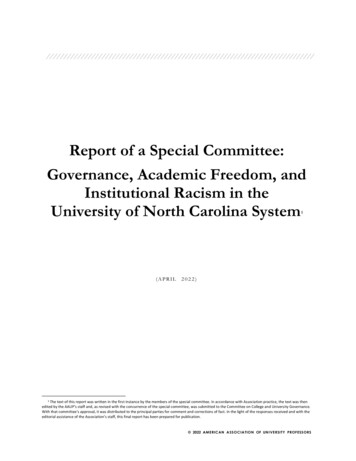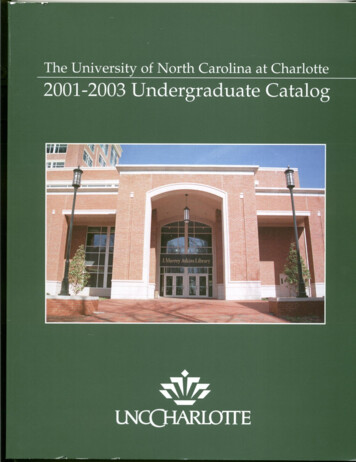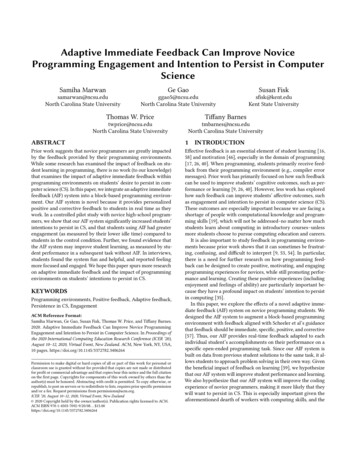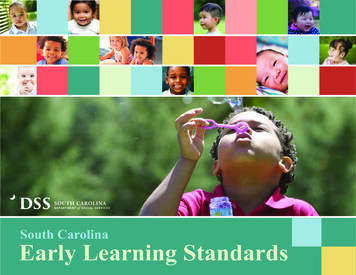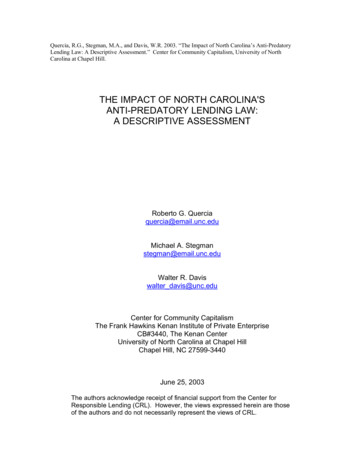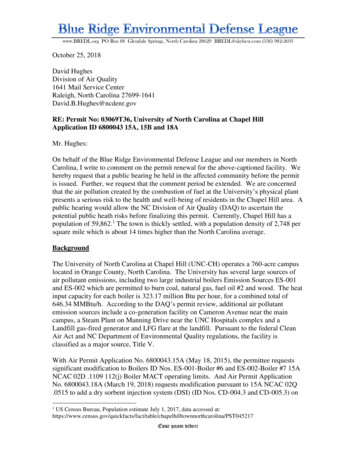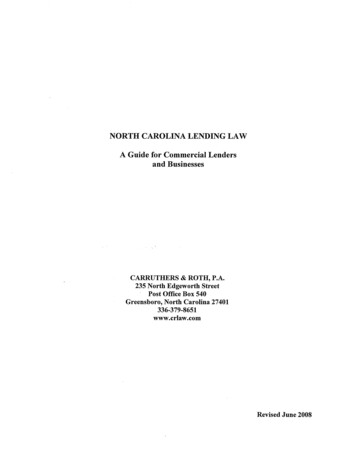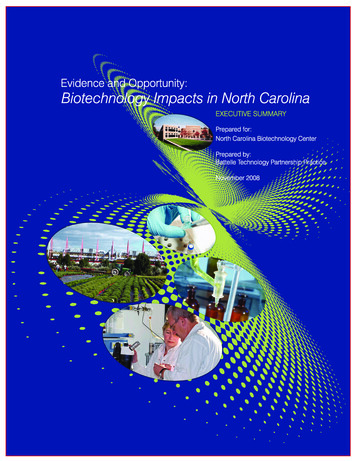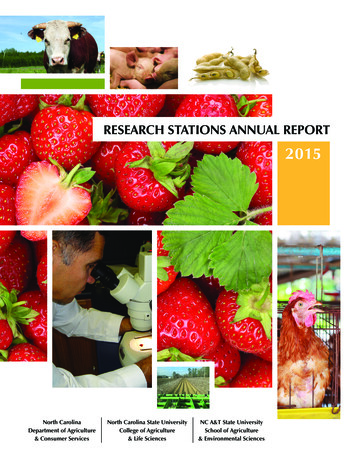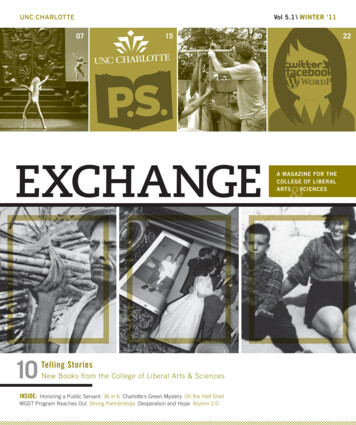
Transcription
Vol 5.1 \ Winter ’11Unc charlotte071520EXCHANGE10Telling StoriesNew Books from the College of Liberal Arts & SciencesInside: Honoring a Public Servant 36 in 6 Charlotte’s Green Mystery On the Half ShellWGST Program Reaches Out Strong Partnerships Desperation and Hope Alumni 2.022A magazine for thecollege of liberalartssciences
EXCHANGEthe magazine for the college of liberal arts & sciences10Telling StoriesCelebrating the commonality ofnarrative, three new books fromcollege faculty help us make senseof the world around us.noteworthy6In Every IssueHonoring a Public ServantFriends Mobilize to Set Up a Scholarship in SusanBurgess’ Name16Women’s and Gender StudiesProgram Reaches Out3471822Dean’s LetterNewsHighlightsOutlookSpotlightWhere Academics Meets Activism20Desperation and HopeAddison Hodge’s Month in Haiti22Alumni 2.0UNC Charlotte Grads Make Waves with Social MediaThe College of Liberal Arts & SciencesUNC Charlotte9201 University City Blvd.Charlotte, N.C. 28223clas.uncc.eduCONTRIBUTORSWith special thanks to photographer Wade Bruton.Editor Allison ReidDesign Bright Yellow JacketSend comments to: allison.reid@uncc.edu.Contributing WritersDena Shenk, James Hathaway, Addison Hodge15,000 copies of this public document wereprinted in December 2010 at a cost of 12,945.00 or .86 per copy.
dean’s letterDear Alumni Friends,Once, when I was in college, my roommate and I were watching a TVdrama, when the plot took a strange direction, presupposing eventsthat we had not seen. Somewhat disconcerted, at the next commercialwe discussed our confusion, realigned the story and made sense of the seeminggaps in the plot. But then, much to our surprise, after the TV drama resumed,we saw a replay of several earlier scenes, followed by several scenes we hadnot seen that filled in important plot points, and finally, the scene that createdour first confusion. We suddenly realized that the television station indeed hadinadvertently dropped a “middle” between scenes, and that our initial confusionabout the plot had been warranted.This particular incident stays with me because it is such a good example ofhow human beings make sense of the world. My roommate and I had been givenmuddled information, yet we logically took the information we had and createda coherent story that tied up the narrative loose ends. What had been confusionbecame, in our reworking, meaning. I also like this story because, on the one hand,it is so mundane, and yet on the other, it is anything but mundane. Every humanDEAN NaNCY A. GUTIERREZbeing, every single minute of the day, makes meaning out of the experiences she isCollege of liberal arts & scienceshaving. This issue of Exchange is an apt example of this practice.Before they began writing, Jim McGavran, Christine Davis and Tom Rogers,featured faculty members in the cover story, each assembled a myriad of facts,observations and impressions, and then, from this myriad shaped their separatestories. In our alumni profile, we see Eva Rykr (psychology) and Rhiannon Bowman (communication studies),making meaning of ideas related to their professions, but doing so by using the newest social media toolsand relating their stories in new ways to new audiences.But there are other ways of making meaning.Ross Meentemeyer, professor of geography, is studying Charlotte’s urban ecology, making sense of a vibrantcity’s continual act of “becoming” a model of sustainability and growth. And biology professor Jim Oliver hasbeen working for much of his career to “make sense” of the bacterial pathogen, Vibrio vulnificus, the mostfatal food-borne pathogen in the world.The friends of Susan Burgess certainly found value and meaning in her life of civic service. However, notcontent to put an end to this meaningful life of dedication, they elected to extend her impact by providingscholarship support for students following in her footsteps as a public servant.The Model UN students, successful as debaters in an academic environment removed from the realities ofissues they study, are in the process of changing the nature of their organization: in addition to its traditionalidentity as a training ground for an informed and engaged citizenry, the Model UN at UNC Charlotte isexpanding the meaning of its organization to embrace human rights activism, specifically in service learningin Haiti.Making meaning is a human habit of mind. And as so many stories in this issue demonstrate, it is both anintellectual and experiential pursuit. I invite you to make your own meaning, as you enter this latest issue ofExchange.3
142news314Bella Bloomed Again!What plant grows a single giant leaf for 12 months or so, disappearsentirely for six to nine months, sprouts a new leaf for another year, and repeatsthis cycle for at least 12 years . . . until it pushes forth from its pot a flowerso large, so smelly, and so rare, that 4,000people rush over to bask in its brief, but spectacular display?UNC Charlotte’s own Titan Arum, or “Bella,”of course! The botanical superstar that callsthe McMillan Greenhouse home delighted faculty, staff and community members with itssecond bloom on June 22, several days earlierthan anticipated. The Greenhouse staff got theword out about the early bloom, and thousandscame to see the 34-inch, deep burgundy andyellow-spiked bloom before it faded on June24 (more quickly than usual, perhaps due towarmer-than-average conditions).According to assistant greenhouse direc-2tor, Paula Gross, pollination was attempted, but Bella did not produceseed. “Producing such large bloomstakes a great deal of energy, andsince this was her second time (shebloomed for the first time in 2007 tomuch fanfare), she used up her tuber,” Gross says.So, while campus bid farewell toits beloved Bella, everyone can lookforward to possible stinky events inthe future — the McMillan Greenhouse staff are currently nurturingtwo six-year-old Titan Arums. Thatmeans UNC Charlotte freshmen notonly have football to look forward tobefore they graduate, but maybe another Titan bloom, as well.CTI earns over 300,000 in national and local grant awardsCharlotte Teachers Institute (CTI) continues to make greatstrides in providing professional development opportunitiesfor Charlotte Mecklenburg Schools (CMS) teachers andgarnering support from national and local community partners and foundations. CTI has earned grants totaling over 300,000 this year, including a recent 200,000 awardfrom the Arthur Vining Davis (AVD) Foundations. “In a highlycompetitive evaluation process involving strong proposalsfrom across the country, the CTI distinguished itself as a toptier organization with the potential to have lasting impacton CMS teachers and students,” said William Keator, vicepresident for programs at the AVD Foundations.CTI’s Founding Director Molly Shaw said other recentgrants include: Arts and Science Council, Belk Foundation, Charlotte Mecklenburg Community Foundation, Imago Mundi Endowment Fund, Knight Foundation, PiedmontNatural Gas, UNC Charlotte’s Chancellor’s Diversity Challenge Fund and Wells Fargo Foundation.CTI is an initiative designed to strengthen teaching bycultivating content knowledge, creativity, leadership skillsand collaboration within and among local public schoolteachers. CTI is a partnership among UNC Charlotte, Davidson College and CMS, and is made possible by a jointcommitment of resources and energy from all three Institute partners and through the generosity of private funders.Starting in 2009, Charlotte Teachers Institute has conducted professional development seminars for over 150CMS teachers, with six UNCC faculty members leadinghalf of CTI’s 12 seminars (Davidson College faculty alsoled six seminars). These six UNCC faculty members taught75 CMS teachers who in turn have taught over 6,000 localstudents in grades K-12. Each teacher earned 30 hours
newsof professional development creditfor a total of 4,500 hours, including2,250 hours contributed by UNCCfaculty alone. CTI also coordinated local teachers’ involvement in summerseminars at Yale University, boostingCTI’s total professional developmentcontribution to over 5,000 hours.3English ProfessorOrganizes “A Tribute toNovello”Mark West, a professorin the English Department,helped an ailing Charlotte tradition by organizing “A Tributeto Novello,” which took placeOct. 1, 2 and 9.Novello, a popular literary festivalnormally produced by the CharlotteMecklenburg Library, is on hiatus dueto budgetary cuts.“I felt like the community had benefited from Novello for all these years,and maybe it was time for the community to show its appreciation to thelibrary for what the festival has come tomean,” explained West.Instead of a week’s worth of events,“A Tribute to Novello” took place during two weekends. The first weekend,Oct. 1-2, featured adult authors, andOct. 9 featured young adult and children’s authors.UNC Charlotte faculty membersAaron Gwyn and Aimee Parkison,English, and Andrew Hartley, theatre,participated in panel discussions.University librarian Stanley Wildermoderated a panel on mystery writing,and students from a number of classesserved as volunteers.4In Memoriam: Dr. Schley LyonsDr. Schley Lyons, former long-time dean of the College of Artsand Sciences, died July 17. Dr. Lyons joined the faculty of UNC Charlottein 1969 as chair of the department of political science, a position he held for 11years. During that time, he established the department of criminal justice andcriminology in l971 and developed a graduate program in urban administration.Lyons was appointed associate dean of the College of Arts and Sciences in 1980and interim dean in 1985. Following a national search, he was appointed deanand held the position until he retired in 2005. Under his leadership, the numberof faculty and students in the College nearly doubled, new departments and programs were added, and external funding and faculty research in the college grewsignificantly, which greatly enhanced the growing reputation of UNCCharlotte as a major research university.Dr. Lyons earned his PhD from American University in 1964. Hisresearch areas included North Carolina state and local politics andAmerican Electoral behavior.His distinguished legacy includes the founding of Leadership Charlotte, which has cultivated over 1,000 community leaders since itsinception in 1978, and the UNC Charlotte Taft Institute for Two-Party Government,which taught thousands of secondary school teachers to place real politics at thecenter of their teaching of social studies. In recognition of Dr. Lyons’ 36 years ofdedicated service to UNC Charlotte and the greater community, a lecture hall inFretwell Hall is named in his honor.The family requests that, in lieu of flowers, memorial gifts may be made tothe UNC Charlotte Department of Political Science, in care of the UNC CharlotteFoundation, 9201 University City Blvd., Charlotte, N.C., 28223.5In Memoriam: Dr. Mike EldridgeDr. Mike Eldridge, department of psychology, died unexpectedlySept. 20. Eldridge came to UNC Charlotte’s philosophy department in 1995 afterserving as chair of the department of philosophy and religion at nearby QueensUniversity. In 2004, he was awarded a Fulbright Scholarship, and previously heheld a Democracy in Education Fellowship at the Center for Dewey Studies. Hisdegrees included a PhD from the University of Florida, a Masters from ColumbiaUniversity, and Bachelor degrees from Harding College and Yale Divinity School.After officially retiring in 2008, he continued to teach, to advance the causes ofPragmatism and applied philosophy, and to provide a multidimensional universityresource. Mike will be missed and long remembered by those who knew him. Withhis wit, charm, and energetic intelligence, he enriched the conversation of humanity called “philosophy.”5
6spotlightdonorHonoring a Public ServantFriends Mobilize to Set Up a Scholarship in Susan Burgess’ NameLong-time Charlotte City Council member andMayor Pro Tem Susan Burgess was a fixture inlocal Charlotte politics for years. An at-largemember of city council since1999, Burgess chaired the CityCouncil Housing and NeighborhoodDevelopment and EconomicDevelopment committees during hertenure. In addition to serving as mayorpro tem for six years, Burgess servedon the Charlotte Mecklenburg Boardof Education from 1990 to 1997, thelast two years as chair.“She was just a force,” says closefamily friend Mary Hopper, executivedirector of University City Partners.“She was the driving force in herfamily, her neighborhood, her church,and of course in the community.”Susan BurgessEven while battling colorectal cancerfor three years, Burgess was a tireless presence in thecommunity. But when she publicly announced in May thatshe was losing the battle against her disease and enteringhospice care, it left her friends and colleagues reeling. Italso left them wondering about her legacy.UNC Charlotte first lady, Lisa Lewis Dubois — whohad been friends with Burgess since working with heron a National League of Cities Women in MunicipalGovernment event — sprang into action and made plans todevelop a memorial scholarship in Burgess’ name. She feltit fitting that the scholarship be created at UNC Charlottebecause so many city and county public servants aregraduates of the master of public administration program,housed in the College of Liberal Arts and Sciences’department of political science.Dubois learned that to endow the scholarship, she wouldneed to raise 25,000.“Everyone knew we didn’t have much time, that we hadto mobilize quickly,” says Dubois.Dubois called Mary Hopper and told her about the planand the amount of money that needed to be raised.“I said, ‘We can make this happen,’” Hopper recalls.Hopper and Dubois worked their phone tree andgarnered commitments to contribute to the scholarshipfrom Burgess’ many friends andsupporters. They also checked withother community leaders, like CharlotteMayor Anthony Foxx and FoundationFor The Carolinas President and CEOMichael Marsicano, to make sure theirplans weren’t interfering with otherefforts to memorialize Burgess.“Everyone we talked to embraced itand told us to go full force with theirblessing,” says Dubois.Within days, Dubois says, she knewthey were going to reach their goal.When Hopper realized the scholarshipwas going to be a reality, she checked inwith her dear friend to get her blessing.“Susan was very much alert in thelast days and weeks, and she was in ‘checking off’ mode,”Hopper recalls. “When I told her about our plans, she wasso pleased, and I think we may have checked off a taskthat she didn’t even know she had.”“The scholarship is a fitting legacy for Susan,”says Dubois. “Although her passion and energy areirreplaceable, the fellowship will enable students to carryon Susan’s example of public service.”“In my mind Susan was the very definition of the‘servant leader’ in her position on the Council,” saysHopper. “And what better way to give longevity to herservice than to support future community leaders in UNCCharlotte’s MPA program.”The first scholarship is set to be awarded in fall 2011.For more information, or to contribute to the SusanM. Burgess Scholarship in Public Administration, pleasecontact Sharon Harrington, College of Liberal Arts andSciences Director of Development, at 704-687-0082 orscharrin@uncc.edu.words: Allison Reid[alumni spotlight on page 22}
highlightshumanities36 in 6Shakespeare By the Numbers“What’s in a name? That whichwe call a rose by any other wordwould smell as sweet.”— “Romeo and Juliet” (II, ii, 1-2)“What’s in a name,” is a question UNC Charlotteassociate professor of English Kirk Melnikoff is getting alot these days, regarding the new “36 in 6” project he’scollaborating on with his colleagues from the Shakespearein Action (SIA) Center. Luckily, he has a good answer.Launched this past April, the 36 in 6 series willmount six Shakespeare-related events for six years,according to Melnikoff, so that by the 400th anniversaryof Shakespeare’s death (April 23, 2016, to be exact),they will have staged in some form the majority ofShakespeare’s plays. The events will include majorproductions, staged readings and the performance ofselected scenes, alongside public lectures, colloquia andguest appearances.But, “why” (or “wherefore,” as Shakespeare mighthave written), one might ask? Melnikoff can answer thatquestion, as well.“We are putting on this program to share our love ofShakespeare, particularly of Shakespeare in performance,with the larger Charlotte community in honor of theupcoming 400th anniversary of his death,” Melnikoffsays. “Anyone interested in Shakespeare’s plays, hiscareer, his time period or the theater in general will enjoyour events.”The other goal of the series, according to Melnikoff, isto introduce the local community to the new Shakespearein Action Center at UNC Charlotte, which bringstogether more than a dozen UNC Charlotte faculty withexpertise in Shakespeare and the Renaissance. Amongother outreach activities, the Center is responsible forproducing the Shakespeare Bulletin, the premiere journaldedicated to Shakespeare in performance. Melnikoff,currently communications officer for the SIA center,helped found it four years ago, along with current centerdirector Andrew Hartley, Distinguished Professor ofShakespeare, and associate director Jennifer Munroe,associate professor of English.The series was launched April 24 with a lecture about“Shakespeare’s Gardens,” which focused on “Richard II.”Other events included the SIA Center’s 7th Annual SonnetSlam, featuring hip hop artist “CStar;” a workshop andlecture by Melnikoff; and a guest lecture by acclaimedscholar Stuart Hampton-Reeves, University of CentralLancashire, titled, “Shakespeare’s Worst Plays? Performingthe three parts of ‘Henry VI.’”Forthcoming events in 2011 include a lecture on“Henry VIII;” another workshop by Melnikoff, this time on“Measure for Measure;” and the year’s capstone event,“A Midsummer Night’s Dream,” featuring a lecture byworld-renowned Shakespearean scholar Peter Holland anda performance of the play produced by UNC Charlotte’sTheatre department and directed by Hartley.For more details about upcoming events, visit the SIACenter website: shakespeare.uncc.edu.words: Allison Reid and Fiona Hooverpictures: Kirk Melnikoff, Shakespeare in Action Center7
8highlightssocial sciencesCharlotte’s Green MysteryRoss Meentemeyer Studies the Urban EnvironmentCharlotte, N.C., is a rapidly growing city. Charlotteis also a green city. Some people might see thatas a contradiction.In Charlotte, there are wooded lots and remnant farmsplots almost in the shadow of the towers of the nation’ssecond largest financial center. Social scientists findthe co-existence of strong urban growthand persistent green areas puzzling.The National Science Foundation thinksthat Charlotte’s complex environmentmight make an interesting site for longterm research in urban growth andsustainability.Researchers at UNC Charlotte, led byRoss Meentemeyer, professor of Geographyand Earth Sciences, have been awarded 300,000 by NSF’s Urban Long-TermRoss MeentemeyerResearch Areas Exploratory ResearchProjects (ULTRA-EX) competition — one of 17 nationalawards given for pilot urban research projects. Theexploratory projects are research trials that may lead tothe later award of an ULTRA site — the establishment ofa long-term study site with major NSF funding for urbanenvironment research.Charlotte, which has experienced dynamic urbangrowth without losing all the pastoral charms of the NorthCarolina piedmont, may offer scientists an ideal livinglaboratory to study what makes a “human-dominatedecosystem” tick.“We have the opportunity to track and understandwhat is going on because we are catching Charlotte earlyenough in its growth trajectory,” said Meentemeyer, theULTRA-EX grant’s principal investigator.“Because of that we have a chance to determine ifthere are possibilities for alternative futures for Charlotte.Charlotte might be one of the best examples of a cityprojected to grow so fast and so big — we have aunique opportunity here to watch development,”Meentemeyer said.Meentemeyer, a landscape ecologist and executivedirector of UNC Charlotte’s Center for Applied GeographicInformation Science, heads the inter-disciplinary researchteam. Other members of the research group are JeanClaude Thill, Knight Distinguished Professor of Geographyand Earth Sciences at UNC Charlotte, who is an authorityon urban systems and modeling; William Ribarsky, chairof the Department of Computer Science and director ofthe Charlotte Visualization Center; Chunhua Wang, anenvironmental economist from the Renaissance ComputingInstitute branch at UNC Charlotte; and Todd BenDor,assistant professor in the Department of City & RegionalPlanning at UNC Chapel Hill and an authority on land useplanning and public policy.While the project will perform basic research on urbandynamics and links between economic and environmentalsustainability, the science will be tied to real life issuesand will closely involve the ongoing work of local agenciesand land management professionals.The Charlotte ULTRA exploratory project will focusparticularly on the issue of the “persistence” of forest andfarm lands within the urban boundaries. In Meentemeyer’swords, the project aims to answer the essentialquestion: “Hidden in Charlotte’s current dynamic urbanenvironment, are there alternative futures for growth whereurbanization, forest and working lands can co-exist in aneconomic and environmentally sustainable fashion?”At the heart of the project is a two-year plan to developa complex and sophisticated computer model that willallow the researchers and land planning partners toexamine such “alternative futures” that might result froma wide variety of new variables – new laws and regulations,changing economic, political or environmental conditions,or emerging social and cultural forces.words: James Hathawaypictures: Ross Meentemeyer
highlightsmath & scienceOn The Half ShellJim Oliver Warns Us of a Fatal Food-borne PathogenFor those who love them, there is nothing tocompare with the experience of the cold, plump,raw oyster, sipped from its shell. Unfortunately,even a brief conversation with UNC Charlotte’s Jim Oliverwill make you think twice about eating Oysters on the HalfShell ever again.Oliver, Bonnie E. Cone Distinguished Professor forTeaching, is probably the foremost expert on the bacterialpathogen Vibrio vulnificus. This is the most fatal food-bornepathogen in the world, most commonly found in shellfish,like oysters. Although it is rare to become infected by thepathogen, the fatality rate is about 50 percent for those whodo become infected, according to Oliver.“It takes about 100 cells of the pathogen to infect you,and one oyster can easily host 1,000 to one million cells,”says Oliver. “One oyster is all it takes.”This fall, Oliver was invited jointly by the UnitedNations’ Food and Agriculture Organization (FAO) andthe World Health Organization (WHO) to participate in aninternational panel in Rome to develop risk assessmenttools to evaluate the hazards of V. vulnificus associatedwith seafood, and to help develop guidelines for theentire world.This recognition by the two United Nations’health agencies was, Oliver says, a major honor and arewarding recognition of a career of over 40 years workingon the organism and publishing hundreds of articles onthe subject.The average healthy person won’t become infectedwith V. vulnificus, according to Oliver. There are onlyaround 30 to 40 cases reported each year in the UnitedStates. Even so, Oliver says that he no longer eats rawoysters. It’s a “very ugly disease,” he says, most commonlyaffecting men over the age of 40. The bacterium worksits way through the bloodstream to the legs and causestremendous muscle and tissue damage. If a personsurvives long enough, they may have their legs amputated.The only people who become infected by the pathogenalready have an underlying disease, but the federalgovernment estimates that there are between 15 and 20million people with an underlying disease, making for ahuge at-risk population.That explains why theWHO and FAO are interestedin developing internationalguidelines for shellfish safety,Oliver says. The panel,consisting of 17 experts from11 countries, met for five daysand developed a 45-page draftof recommendations for shellfishJim Oliverhandling and testing.Currently, according to Oliver, testing for V. vulnificusin oysters is problematic. First, the only way to test anindividual oyster means destroying it. Secondly, there ishuge variation in the V. vulnificus numbers among oysterpopulations carrying the pathogen.“You could take two oysters side-by-side in the ocean,and one would have it and one wouldn’t,” says Oliver.Even steaming the oysters doesn’t completely negatethe risk of consuming the bacteria, according to Oliver.However, he is hopeful that a new post-harvesting processthat kills all the bacteria in an oyster might become moreprevalent. Until that day, Oliver says, he enjoys his oystersfried.words: Allison Reidpictures: Jim Oliver9
TELLINGSTORIESNew books from the college ofliberal arts & Scienceswords:Allison reidThe inclination to tell a story, to record our history and tosomehow illuminate our lives through sharing, is as ancientas civilization itself. In that great tradition, the faculty of UNCCharlotte’s College of Liberal Arts and Sciences publish dozens ofbooks annually, on subjects ranging from poetry to Pinochet. Forthis issue of Exchange, we are highlighting three books that standout from the list, each telling its own important story. Celebratingthe commonality of narrative, be it personal or global, these threevery different books share the same goal: to make sense of theworld around us.
12TellingStoriesThe Deepest WoundsAfricana studies assistant professor Tom Rogers grewup in West Virginia, in the heart of Appalachia, where heobserved two phenomena, in particular, that have stayedwith him in the years since. First, he discovered the deepconnection between the population and the land andhow society is both molded by and molds its landscape.Second, he experienced the long-term patterns ofmistreatment by the logging and coal mining industries onboth the environment and the labor force.“A childhood in Appalachia helped foster a fascinationwith society’s relationship to its surroundings and perhapsled to an intuitive understanding of the paired exploitationof labor and the environment,” he writes in his new book,“The Deepest Wounds: A Labor and Environmental Historyof Sugar in Northeast Brazil (UNC Press, 2010).”These seminal childhood influences, as subliminalas they may have been, affected the course of Rogers’life and career, which began with a job at a non-profitenvironmental organization. Rogers then went on tograduate studies in labor history and Africana studiesTom Rogersand now specializes in 20th century Brazilian history. Hebecame interested in the state of Pernambuco, Brazil’skey northeastern sugar-growing state, no doubt becausehe discovered its unique history tied very much to theland and the labor movement there, and the exploitationof both.In “The Deepest Wounds,” Rogers traces the social andenvironmental changes over four centuries in Pernambuco,with a focus on the period from the end of slavery in 1888to the late 20th century. His book examines the businessof making sugarcane grow, and its deleterious effect onthe environment and its farmers. He combines a study ofworkers with analysis of their landscape and describes theimpact the legacy of the area’s sugarcane industry has hadon Brazil even today.“This work and these lives, tied to the cultivation ofsugarcane, shaped the landscape and drove history,”Rogers writes. “This book tells their story, acknowledginghow closely that story intertwines with the history of thefields themselves.”The story Rogers is telling — one of another countryand another people at another time — is also his story. Inmany ways, he might say it is just another tale like that heheard in the mountains of West Virginia, retold.In the Shadow of the BearJim McGavran, an English professor who specializesin Wordsworth and the Romantics, made a career out ofstudying and teaching the tales that others have told. Heteaches students how to read and interpret the classics,how to apply the lessons of years past to modern-daystruggles. It was not until relatively late in his career thathe realized he might have his own story to tell.Like Rogers, McGavran’s story is very much tied to theland. His recently published memoir, “In the Shadow ofthe Bear: A Michigan Memoir (Michigan State UP, 2010),”largely takes place at Little Glen Lake in northwesternLower Michigan’s Leelanau peninsula, his childhoodfamily vacation spot for over a decade. The area holds avast store of memories for McGavran, many of which werenot unearthed until his return there, with his own family,some 40 years later.(cont. on p. 14)
TellingStoriesCLAS BOOKS ROUNDUPBooks published by faculty in the College of Liberal Arts & Sciences in 2010Africana StudiesTanure OjaideMatters of the MomentThomas D. Rogers The Deepest Wounds: A Labor andEnvironmental History of Sugar inNortheast BrazilBotanical GardensLarry Mellichamp and Paula Gross Bizarre Botanicals: How to Grow String-ofHearts, Jack-in-the-Pulpit, Panda Ginger,and Other Weird and Wonderful PlantsCriminal Justice and CriminologyJoseph B. Kuhns andJohannes Knutsson, eds. Police Use of Force: A Global PerspectiveVivian B. Lord and Allen D. Cowan Interviewing in Criminal Justice: Victims,Witnesses, Clients, and SuspectsKathy Merlock Jackson andMark I. West, eds.Disneyland and Culture: Essayson the Parks and Their InfluencePhilosophyJim McGavranIn the Shadow of the Bear:A Michigan MemoirMalin PereiraInto a Light Both Brilliant and Unseen:Conversations with ContemporaryBlack PoetsLara VetterModernist Writings and Religio-s
years. During that time, he established the department of criminal justice and criminology in l971 and developed a graduate program in urban administration. lyons was appointed associate dean of the college of arts and sciences in 1980 and interim dean in 1985. following a national search, he was appointed dean


